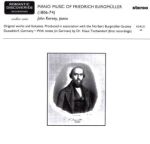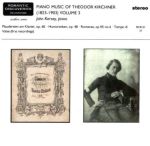
Clara Schumann (1819-96)
Complete transcriptions of Lieder by Robert Schumann
John Kersey, piano
RDR CD25
Price: £12.99. Click the button below to purchase this CD securely online.

Total time: 67 mins 58 secs
1. Widmung (Devotion), op 25 no 1 (2’30”)
2. Freisinn (Forward), op 25 no 2 (1’27”)
3. Schöne Fremde (Far away in happy land), op 39 no 6 (1’43”)
4. Dein Angesicht (Thy lovely face), op 127 no 2 (1’40”)
5. Ich wand’re nicht (The joys of home), op 51 no 3 (1’05”)
6. Märzveilchen (March violets), op 40 no 1 (1’30”)
7. Berg’ und Burgen (Mountains and castles), op 24 no 7 (1’58”)
8. Mondnacht (Moonlight), op 39 no 5 (3’12”)
9. Er ist’s (The return of spring), op 79 no 19 (1’48”)
10. An den Sonnenschein (O sunny beam), op 36 no 4 (1’47”)
11. Mit Myrthen und Rosen (With myrtles and roses), op 24 no 9 (3’58”)
12. Die Stille (Emotion), op 39 no 4 (1’52”)
13. Geständniss (Ever thine), op 74 no 7 (2’25”)
14. Der Nussbaum (The walnut tree), op 25 no 3 (2’55”)
15. Rose, Meer und Sonne (Rose, sea and sun), op 37 no 9 (3’47”)
16. Philinen’s Lied (Philine’s song), op 98 no 7 (2’13”)
17. Volksliedchen (The hat of green), op 51 no 2 (1’27”)
18. Nichts Schöneres (Nothing fairer), op 36 no 3 (2’31”)
19. Du bist wie eine Blume (A floweret thou resemblest), op 25 no 24 (1’13”)
20. Er, der Herrlichste (The noblest), op 42 no 2 (3’06”)
21. Intermezzo (Dein Bildniss) (Thy image), op 39 no 2 (1’55”)
22. Dem rothen Röslein (A red, red rose), op 27 no 2 (1’24”)
23. Der Knabe mit dem Wunderhorn (The youth with the enchanted horn), op 30 no 1 (2’06”)
24. Die Lotosblume (The lotos flower), op 25 no 7 (1’43”)
25. Sehnsucht (Longing), op 51 no 1 (2’24”)
26. Sonntags am Rhein (A holiday on the Rhine), op 36 no 1 (2’54”)
27. In der Fremde (Far from home), op 39 no 1 (1’46”)
28. Frühlingsnacht (A spring night), op 39 no 12 (version 1) (1’32”)
29. Helft mir, ihr Schwestern (The bride’s toilet), op 42 no 5 (1’46”)
30. Ständchen (Serenade), op 36 no 2 (1’31”)
31. Frühlingsnacht (A spring night), op 39 no 12 (version 2) (1’35”)
Clara Schumann (from Wikipedia)
In March 1828, at the age of nine, the young Clara Wieck performed at the Leipzig home of Dr. Ernst Carus, director of a mental hospital at Colditz Castle, and met another gifted young pianist invited to the musical evening named Robert Schumann, nine years older than she. Schumann admired Wieck’s playing so much that he asked permission from his mother to discontinue his studies of the law, which had never interested him much, and take music lessons with Wieck’s father. While taking lessons, he took rooms in the Wieck household, staying about a year, until Wieck left on a concert tour to Paris. In 1830 at the age of eleven, Wieck gave her first solo concert, giving her debut at Leipzig’s famed Gewandhaus, followed by concerts in various cities and towns, including Weimar, where she performed for Goethe, who presented her with a medal with his portrait and a written note saying, “For the gifted artist Clara Wieck.”
Clara Wieck had a brilliant career as a virtuoso pianist from the age of thirteen. In her early years her repertoire, selected by her father, was showy and popular, in the style common to the time, with works by Kalkbrenner, Henselt, Thalberg, Henri Herz, Pixis, Czerny, and her own compositions. As she matured, however, becoming more established and planning her own programmes, she began to play works by the new Romantic composers, such as Chopin, Mendelssohn and, of course, Schumann, as well as the great, less showy, more “difficult” composers of the past, such as Scarlatti, Bach, Mozart, Beethoven and Schubert.
In her nineteenth year, her father did everything in his power to prevent her from marrying Schumann, forcing the lovers to take him to court. During this period Robert Schumann, inspired by his love for Wieck, wrote many of his most famous Lieder. They eventually married on December 12 1840. Wieck-Schumann continued to perform and compose after the marriage even as she raised seven children, an eighth child having died in infancy. In the various tours on which she accompanied her husband, she extended her own reputation beyond Germany, and her efforts to promote his works gradually made his work accepted throughout Europe.
In 1853 Johannes Brahms, age twenty, met Clara and Robert in Leipzig and immediately impressed both of them with his talent. Brahms became a lifelong friend to Wieck-Schumann, sustaining her through the illness of Robert, asking for her advice about new compositions, even caring for her young children while she went on tour. It is clear that they developed a deep and life-long love for each other, although there is no indication that it was ever consummated physically.
Wieck-Schumann’s reputation brought her into contact with the leading musicians of the day, including Mendelssohn, Chopin and Liszt. She also met violinist Joseph Joachim who became one of her frequent performance partners. “One of the most soulful and famous pianists of the day,” said Edvard Grieg.
Clara Wieck-Schumann often took charge of the finances and general household affairs due to Robert’s mental instability. Part of her responsibility included making money, which she did by giving concerts, although she continued to play throughout her life not only for the income, but because she was a concert artist by training and by nature. Robert, while admiring her talent, wanted a traditional wife to bear children and make a happy home, which in his eyes and the eyes of society were in direct conflict with the life of a performer. Furthermore, while she loved touring, Robert hated it.
After Robert’s death (July 29, 1856), Wieck-Schumann devoted herself principally to the interpretation of his works. But when she first visited England in 1856, the critics received Robert’s music with a chorus of disapproval. She returned to London in 1865 and continued her visits annually, with the exception of four seasons, until 1882. She also appeared there each year from 1885 to 1888. In 1878 she was appointed teacher of the piano at the Hoch Conservatory in Frankfurt am Main, a post she held until 1892, and in which she contributed greatly to the improvement of modern piano playing technique.
Wieck-Schumann played her last public concert in Frankfurt in March 1891. Five years later, on March 26, 1896, she suffered a stroke, dying on May 20, at age 77. She is buried at Bonn’s Alter Friedhof (Old Cemetery) with her husband.
Clara Schumann was a woman of great character. She was the main breadwinner for her family through giving concerts and teaching, and she did most of the work of organizing her own concert tours. She refused to accept charity when a group of musicians offered to put on a benefit concert for her. In addition to raising her own large family, when one of her children became incapacitated, she took on responsibility for raising her grandchildren. During a time of revolution in Dresden, she famously walked into the city through the front lines, defying a pack of armed men who confronted her, rescued her children, then walked back out of the city through the dangerous areas again.
As part of the broad musical education given her by her father, Clara Wieck learned to compose, and from childhood to middle age she produced a good body of work. At age fourteen she wrote her first piano concerto, with some help from Robert Schumann, and performed it at age sixteen at the Leipzig Gewandhaus with Mendelssohn conducting.
As she grew older, however, she lost confidence in herself as a composer, writing, “I once believed that I possessed creative talent, but I have given up this idea; a woman must not desire to compose — there has never yet been one able to do it. Should I expect to be the one?” In fact, Wieck-Schumann composed nothing after the age of thirty-six.
Today her compositions are increasingly performed and recorded. Her works include songs, piano pieces, a piano concerto, a piano trio, choral pieces, and three Romances for violin and piano. Inspired by her husband’s birthday, the three Romances were composed in 1853 and dedicated to Joseph Joachim who performed them for George V of Hanover. He declared them a “marvellous, heavenly pleasure.”
“Clara has composed a series of small pieces, which show a musical and tender ingenuity such as she has never attained before. But to have children, and a husband who is always living in the realm of imagination, does not go together with composing. She cannot work at it regularly, and I am often disturbed to think how many profound ideas are lost because she cannot work them out.”
—Robert Schumann in the joint diary of Robert and Clara Schumann.
“Composing gives me great pleasure…there is nothing that surpasses the joy of creation, if only because through it one wins hours of self-forgetfulness, when one lives in a world of sound.”
—Clara Schumann.
Read Full Post »
 Romantic Discoveries Recordings CD26
Romantic Discoveries Recordings CD26










You must be logged in to post a comment.